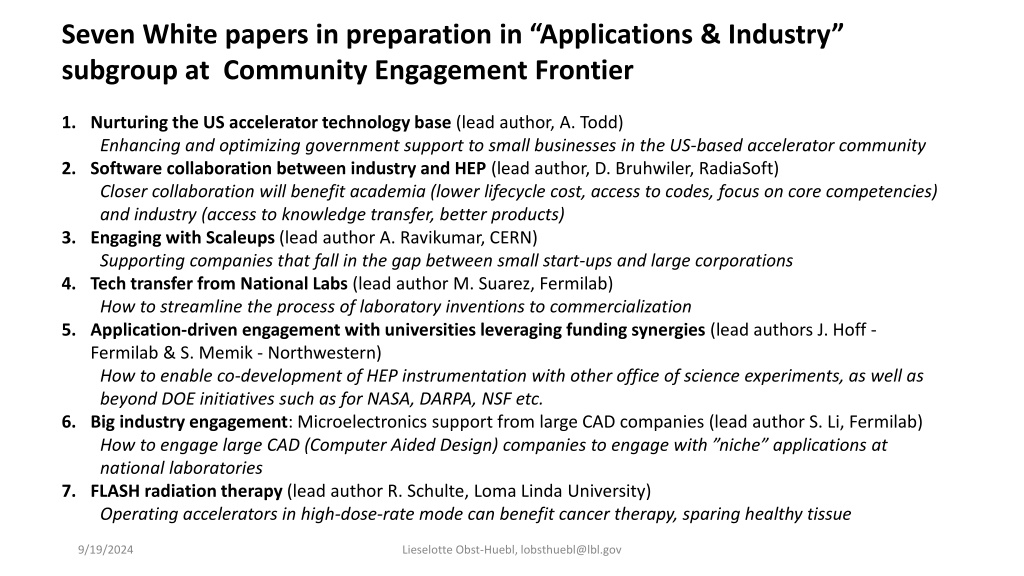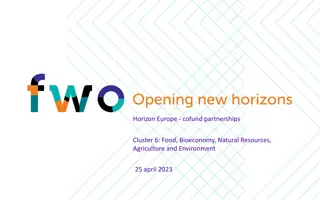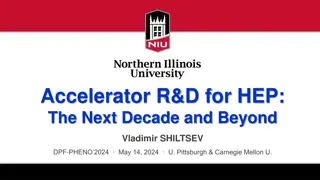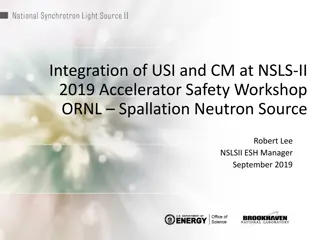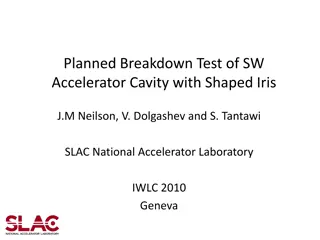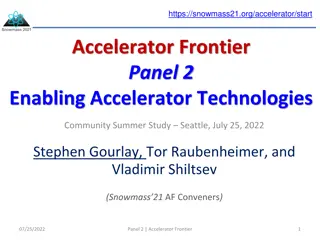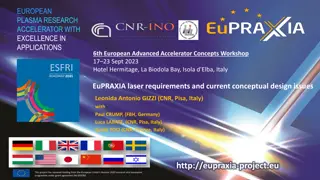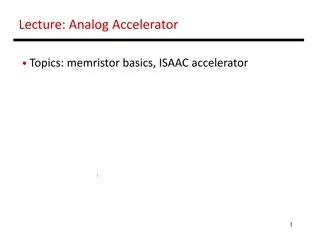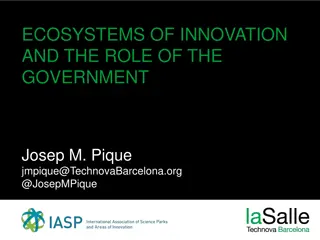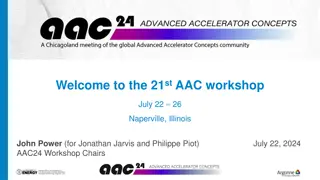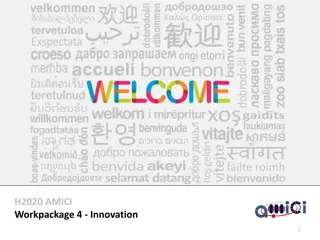Engaging Innovation in Accelerator Technology and Industry Partnerships
This collection of seven white papers explores a variety of topics in the fields of accelerator technology and industry collaborations. Topics range from nurturing the US accelerator technology base to enhancing government support for small businesses in the accelerator community. The papers also delve into software collaboration, engagement with scaleups, tech transfer from national labs, application-driven university engagement, big industry collaboration, and FLASH radiation therapy. These papers highlight the importance of fostering innovation, collaboration, and knowledge exchange across academia, industry, and research institutions to drive advancements in accelerator technology and related industries.
Download Presentation

Please find below an Image/Link to download the presentation.
The content on the website is provided AS IS for your information and personal use only. It may not be sold, licensed, or shared on other websites without obtaining consent from the author. Download presentation by click this link. If you encounter any issues during the download, it is possible that the publisher has removed the file from their server.
E N D
Presentation Transcript
Seven White papers in preparation in Applications & Industry subgroup at Community Engagement Frontier 1. Nurturing the US accelerator technology base (lead author, A. Todd) Enhancing and optimizing government support to small businesses in the US-based accelerator community 2. Software collaboration between industry and HEP (lead author, D. Bruhwiler, RadiaSoft) Closer collaboration will benefit academia (lower lifecycle cost, access to codes, focus on core competencies) and industry (access to knowledge transfer, better products) 3. Engaging with Scaleups (lead author A. Ravikumar, CERN) Supporting companies that fall in the gap between small start-ups and large corporations 4. Tech transfer from National Labs (lead author M. Suarez, Fermilab) How to streamline the process of laboratory inventions to commercialization 5. Application-driven engagement with universities leveraging funding synergies (lead authors J. Hoff - Fermilab & S. Memik - Northwestern) How to enable co-development of HEP instrumentation with other office of science experiments, as well as beyond DOE initiatives such as for NASA, DARPA, NSF etc. 6. Big industry engagement: Microelectronics support from large CAD companies (lead author S. Li, Fermilab) How to engage large CAD (Computer Aided Design) companies to engage with niche applications at national laboratories 7. FLASH radiation therapy (lead author R. Schulte, Loma Linda University) Operating accelerators in high-dose-rate mode can benefit cancer therapy, sparing healthy tissue 9/19/2024 Lieselotte Obst-Huebl, lobsthuebl@lbl.gov
FLASH radiation therapy white paper FLASH: the differential sparing of healthy tissue under irradiation at ultra-high dose rates Previous in-vivo study [1] on mice irradiated with electrons shows differential sparing of healthy tissue when irradiated with constant total dose but different (mean)dose rates (blue vs. red) 0.03 Gy/s (reminder: 1 Gy of dose equals the absorption of 1J of radiation energy per kilogram of matter) 60 Gy/s FLASH-RT could further increase the differential sparing effect and broaden the therapeutic window for radiotherapy as compared to conventional ion sources Shorter total irradiation time in potentially fewer fractions Reduce effects of moving organs during irradiation [1] Favaudon et al: Sci Transl Med. 2014 10.1126/scitranslmed.aba4525, Durante et al., Br Radiol 2018 10.1259/bjr.20170628, Wilson et al. Frontiers in Oncology 2020 10.3389/fonc.2019.01563
1. Nurturing the Industrial Accelerator Technology Base in the US Lead author: Alan Todd, ammtodd@gmail.com The purpose of this white paper is to discuss the importance of having a world class domestic industrial vendors base, capable of supporting the needs of the accelerator facilities, and necessary steps to support and develop such base in the United States. The paper focuses on the economic, regulatory, and policy-driven barriers and hurdles, which presently limit the depth and scope of the broader industrial participation in the accelerator construction projects, discusses international competition landscape, and steps to improve the strength and vitality of the domestic industrial sector in this field. 2. Collaboration between industry and the HEP community Lead author: David Bruhwiler, bruhwiler[at]radiasoft.net Effective long-term collaboration between national laboratories, academia and industry will lead to important benefits for the entire HEP community. Labs and universities will have access to better software with lower lifecycle costs. Companies will be strengthened by knowledge transfer from labs and universities. Computational scientists will be able to concentrate on core competencies, without spending time on UI design, ease of use, cloud computing, etc. Society will reap the benefits of better science, more innovation, and stronger businesses. State-of-the-art simulation codes will become readily available to students. Training time and associated costs will be reduced, as new team members will become productive more quickly. This will contribute to equity, diversity and inclusion (EDI), as barriers to entry are removed for scientists in developing countries and for those at US institutions with less federal funding and no direct access to code developers.
3. Engaging with Scaleups Lead author: Ash Ravikumar, CERN Most National labs have established programs to work with startups and large companies. The gap that has been identified is engaging with Scaleups, which don't fit into either group. This document is a summary of the why, what and how we want to address this. 4. Tech transfer from National Labs Lead author: Mauricio Suarez, Fermilab This white paper focusses on how to facilitate start-ups resulting from National Lab IP. How to create a processes for national lab inventors to commercialize their technology. 4. Tech transfer from National Labs Lead author: Mauricio Suarez, Fermilab This white paper focusses on how to facilitate start-ups resulting from National Lab IP. How to create a processes for national lab inventors to commercialize their technology. 5. Application-driven engagement with universities leveraging synergies with other funding agencies Lead author: Jim Hoff, Fermilab, Seda Memik, Northwestern University This white paper focusses on co-development of applications across various funding agencies. How to enable codevelopment of HEP instrumentation with other office of science experiments as well as beyond DOE initiatives such as for NASA, DARPA, NSF etc. Can engaging Electrical Engineering and Computer Science departments at Universities typically involved in programs supported by other federal agencies to work on HEP instrumentation be a starting step.
6. Big Industry engagement to benefit HEP: Microelectronics Support from large CAD companies Lead author: Shaorui Li, Fermilab The development of modern microelectronics is a highly sophisticated and complex endeavor. There are few companies that have the capabilities to take on this challenge that requires a range of deep expertise in device and circuit performance and their limitations, as well as sophisticated Computer Aided Design (CAD) Electronic Design Automation (EDA) tools. Application Specific Integrated Circuit (ASIC) Design for DOE extreme environments such as high ionization radiation or cryogenic temperatures does not have a significant commercial market to engage large companies in developing the required solutions. DOE national labs with academic and other collaborators spearhead the development of next generation instrumentation required for the DOE mission, however one major bottleneck is the access to low cost, high volume microelectronics CAD tools. The European community has established Europractise software by engaging the large CAD companies to provide reserach licenses we are investigating a similar possibility. 7. FLASH Radiation Therapy Lead author: Reinhard Schulte, rschulte[at]llu.edu The purpose of this white paper is to discuss challenges and opportunities in the emerging field of FLASH radiation therapy (FLASH-RT). FLASH-RT refers to ultra-high dose rate delivery of therapeutic radiation doses within microseconds to a fraction of a second. At these dose rates, radiation-induced side effects are greatly reduced, but tumors are not spared. The white paper will cover promising advances in the accelerator and detector technologies, which could potentially accelerate the development and practical realization of FLASH-RT.
FASH radiation therapy white paper FLASH: the differential sparing of healthy tissue under irradiation at ultra-high dose rates Mean dose rate might be low but instantaneous dose rate >107 Gy/s Previous in-vivo study [1] on mice irradiated with electrons shows differential sparing of healthy tissue when irradiated with constant total dose but different (mean)dose rates (blue vs. red) Laser-driven protons Log(amplitude) Hz Conventional Protons MHz Time 0.03 Gy/s Mean dose rate in research accelerator: ~ 100 - 200 Gy/s (max) in clinical accelerator: ~ 0.01 - 0.4 Gy/s (reminder: 1 Gy of dose equals the absorption of 1J of radiation energy per kilogram of matter) FLASH-RT could further increase the differential sparing effect and broaden the therapeutic window for radiotherapy as compared to conventional ion sources 60 Gy/s ? Shorter total irradiation time in potentially fewer fractions Reduce effects of moving organs during irradiation Laser-driven protons: instantaneous dose rate >107 Gy/s [1] Favaudon et al: Sci Transl Med. 2014 10.1126/scitranslmed.aba4525, Durante et al., Br Radiol 2018 10.1259/bjr.20170628.
